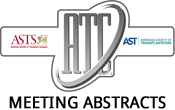2022 American Transplant Congress
Deep Phenotyping Methods Highlight Recipient-Derived CD16+ NK and CD16+ Monocyte Infiltration During Kidney Transplant Rejection
*Purpose: How the immune system participates to kidney transplant rejection has not been fully elucidated. Single-cell (sc) genomics techniques are revolutionizing our ability to characterize…2022 American Transplant Congress
Impact of ATG Dose Reduction on Kidney Transplant Outcomes During the Covid-19 Pandemic
*Purpose: During the COVID-19 pandemic, many transplant centers modified induction immunosuppression regimens. Beginning December 2020, our center reduced anti-thymocyte globulin (ATG) protocol dosing by up…2022 American Transplant Congress
Circulating and Intragraft Donor (HLA)-Specific B Cells Drive Allograft Rejection After Kidney Transplantation
*Purpose: Besides donor-specific antibodies (DSA), circulating donor(HLA)-specific memory B cells (mBc) have also shown to play a deleterious role driving antibody-mediated rejection (ABMR) in kidney…2022 American Transplant Congress
Urinary Cell mRNA Profile Diagnosis of Borderline TCMR in Kidney Allografts
1Nephrology, Weill Cornell-NYPH, New York, NY, 2Pathology, Weill Cornell-NYPH, New York, NY
*Purpose: Borderline T cell-mediated rejection (BR) is associated with inferior outcomes. In the multicenter CTOT-04 study, we discovered and validated a urinary cell three-gene signature…2022 American Transplant Congress
Synergistic Effect of CXCR5+CD8+ TAb-supp Cell Adoptive Cell Therapy and mTOR Inhibition (but Not Calcineurin Inhibition) in Suppressing Alloantibody Following Kidney Transplant in Mice
*Purpose: We have reported that CXCR5+CD8+TAb-supp cells mediate suppression of alloantibody (alloAb) production and prolong graft survival in both hepatocellular and kidney transplant (KTx) mouse…2022 American Transplant Congress
Significance of Gene Polymorphism on Infectious Complications and Rejection After Liver Transplantation
*Purpose: Clinical application of gene polymorphism is a key of precision medicine in the field of organ transplantation. Hiroshima group reported significance of Fc-gamma receptor…2022 American Transplant Congress
Assessing Proportion of Days Covered (PDC) of Mycophenolate (MCP) Prescriptions in Post Kidney Transplant (KT) Recipients as a Predictor of Clinical Outcomes
*Purpose: Nonadherence to medications following KT is a risk factor for adverse outcomes. PDC is an objective measure of adherence obtained through retail prescription records…2022 American Transplant Congress
Impact of Sars-CoV-2 Vaccination on Donor-Derived Cell Free DNA Levels in Renal Transplant Recipients
Columbia University Irving Medical Center, New York, NY
*Purpose: COVID-19 poses a disproportionate threat to renal transplant recipients (RTR), who are chronically immunosuppressed. Studies have indicated a 16% mortality rate compared to2022 American Transplant Congress
Early Experience with OmniGraf® Biomarker Surveillance in Kidney Transplant Patients in the First-Year Post-Transplant and Beyond
*Purpose: Non-invasive rejection biomarkers continue to evolve with recent data supporting the use of combined gene expression and donor derived cell-free DNA (dd-cfDNA) in kidney…2022 American Transplant Congress
Evaluation of the Significance of Isolated C4d Staining without Histological Evidence of Rejection on Kidney Biopsies After ABO-Compatible Transplantation in Pediatric Recipients
*Purpose: C4d staining in peritubular capillaries has been part of ABMR Banff definition since 2003. Despite relatively high specificity, c4d staining shows limited sensitivity, and…
- « Previous Page
- 1
- …
- 11
- 12
- 13
- 14
- 15
- …
- 172
- Next Page »
